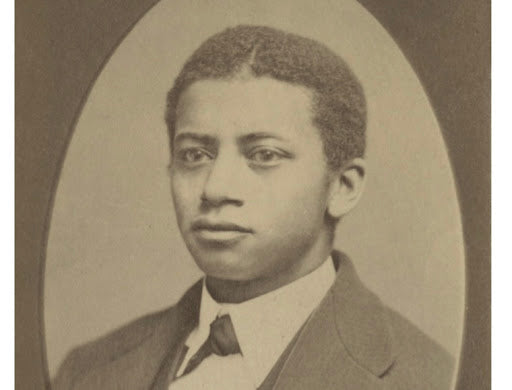He was a pioneer in every sense of the word!
George Franklin Grant was born in 1846 to parents Tudor Elandor and Phillis Pitt Grant, the Harvard School of Dental Medicine reports. Tudor was born into slavery in 1800, running away from Maryland before settling in Oswego, New York in 1832. The elder Grant became a fierce abolitionist, working as a conductor on the Underground Railroad as enslaved people escaped across Lake Ontario to Canada. An article published in 1838 in the Friend of Man newspaper about Tudor states, “Mr. Grant was once a ‘chattel,’ although he spoke as though he felt himself to be a man, and as having always belonged to the race [of men].”
By 1854, Grant had been born and his father had become a popular barber in the community, purchasing a plot of adjoining land that the family’s home sat on. As a result, Grant and his siblings had a great upbringing, even attending an integrated school growing up. However, when Grant was 15, he and his father got into an argument about appropriate clothing for a child his age, Grant leaving the home and being forced to fend for himself. He landed a gig as an errand boy for a local dentist, working his way up there to laboratory assistant where he worked for five years, learning the basics of the dental practice. In 1867, when he was 21, Grant moved to Boston, a new hub for free and formerly enslaved Black people.
Despite Tudor’s antislavery work in Oswego, Boston had become the new epicenter for abolition work with figures like William Lloyd Garrison, William Cooper Neil, Lewis Hayden, and Charles Sumner setting up camp in Beantown. Many African-Americans migrated to Boston post-Civil War in search of educational and economic opportunities. Grant found a home in the city, moving in with a well-known influencer named John J. Smith, who was also an abolitionist, barber and conductor on the Underground Railroad, just like his father.
Smith’s home not only served as a refuge for Smith, it also provided him with an optimal location, situated in the Beacon Hill neighborhood, it was very close to the newly opened Harvard Dental School. Equipped with his previous experience as a dental assistant, Grant was able to secure a job as a laboratory assistant at Harvard Dental School. By the next year, he had done such great work that they offered him an opportunity to attend the school. In 1870, he became one of 12 students to graduate from the dental school, earning a note of distinction.
In 1871, Grant was given a job as an assistant in the Department of Mechanical Dentistry, where he became a pioneer in treating those dealing with cleft palates. He became internationally known for his work with those dealing with the condition, inventing and patenting a prosthetic device called the oblate palate that can be worn by patients, allowing their palates to move into proper physical alignment so they can speak and eat with ease. In 1884, he was promoted to a faculty position of Instructor in Treatment for Cleft Palate and Cognate Diseases, making history as the first Black professor at Harvard University and the first African-American dental education faculty member in the nation. After 19 years as a professor at Harvard, Grant eventually retired from the university to open his own dental practice, Harvard University President Charles Eliot signing up as one of his patients. Many would travel from far and wide to visit Dr. Grant, traveling from places like Michigan and Canada. Grant stayed connected to the University as a member and eventually president of the Harvard Dental Alumni Association.
Dr. George Franklin Grant, the
first African-American professor at
Harvard and invented The Golf Tee.This was after constant frustrations trying to keep the ball from rolling away as he attempted to tee off. pic.twitter.com/vudjSkjUV4
— AFRICAN & BLACK HISTORY (@AfricanArchives) April 22, 2022
advertisement
During his free time, Grant was an avid golfer with reports showing that he and his friends may have been some of the first African-American golfers in the post-Civil War era. His daughter, Frances, once recalled often caddying for her father during the 1880s in the Arlington Heights neighborhood of Boston where Grant had built a golf course next to his home. In spite of his love for the game, there was one aspect he hated: having to tee up the ball. According to him, it was “messy and unsanitary.” During those times, it required players to pinch moist sand and mold a cone-shaped tee. Desperate for an alternative, Grant came up with a new invention that would revolutionize the game. On December 12, 1899, Grant received the patent for a wooden golf tee. It was described as possessing a rigid base portion with an attacked flexible head, the base made of wood that tapered to a point at the lower end that could be inserted into the ground. The tee was made of a gutta-percha crown, a type of latex material used in dentistry to fill root canals, “with an annular seat on which the ball would rest as in a cup, resembling today’s modern tee.”
While he was the inventor, Grant never marketed the tee, choosing instead to pass them out to friends and playing partners. In 1910, Grant passed away at the age of 64 from liver disease. More than eight decades later, in 1991, the United States Golf Association recognized Grant for his innovative contribution to the sport. Today, the Harvard School of Dental Medicine has established an endowed scholarship in honor of its first African-American pioneers, which include Drs. Freeman, Franklin, and Grant. The scholarship covers the tuition for exceptional students who come from underserved or economically disadvantaged backgrounds interested in earning a predoctoral (DMD) degree.
Thank you Dr. Grant! Because of you, we can!
Dr. George Franklin Grant: The inventor, dentist and Harvard’s first Black professor. Photo Courtesy of Harvard School of Dental Medicine

